Feb Exam
Unit 2 Review
Ecological succession
The process by which the structure of a biological community evolves.
There are two types of succession, primary and secondary.
Primary succession
Occurs in essentially lifeless areas - regions in which the soil is incapable of sustaining life as a result of factors such as lava flows, newly formed sand dunes, or rocks left from a retreating glacier.
Secondary succession
Occurs in areas where a community previously existed and has now been removed. It is typified by smaller-scale disturbances that do not eliminate all life and nutrients from the environment.
Pioneer species
Species that are the first to colonize newly created environments or recently disturbed environments during the process of primary and secondary succession. These include lichens, mosses, and fungi.
Succession
Ecological succession is a series of progressive changes in the species that make up a community over time.
Indicator species
A species that provides information about the health and condition of an ecosystem. It is often used to assess the presence or absence of certain environmental conditions or changes.
Over many years, due at least in part to changes in the environment caused by the growth of grasses and other species, shrubs will emerge, followed by small pine, oak, and hickory trees. Eventually, barring further disturbances, the oak and hickory trees will become dominant and form a dense canopy, returning the community to its original state.
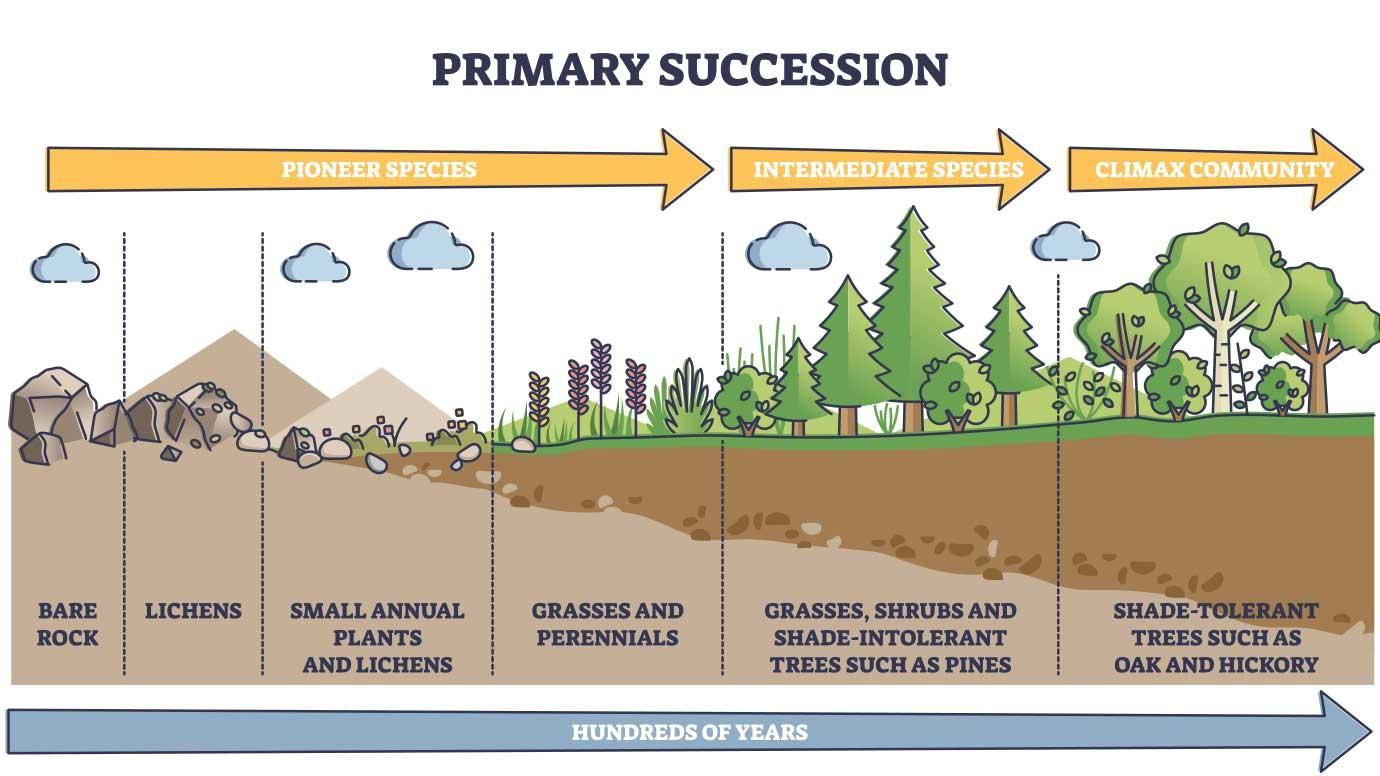
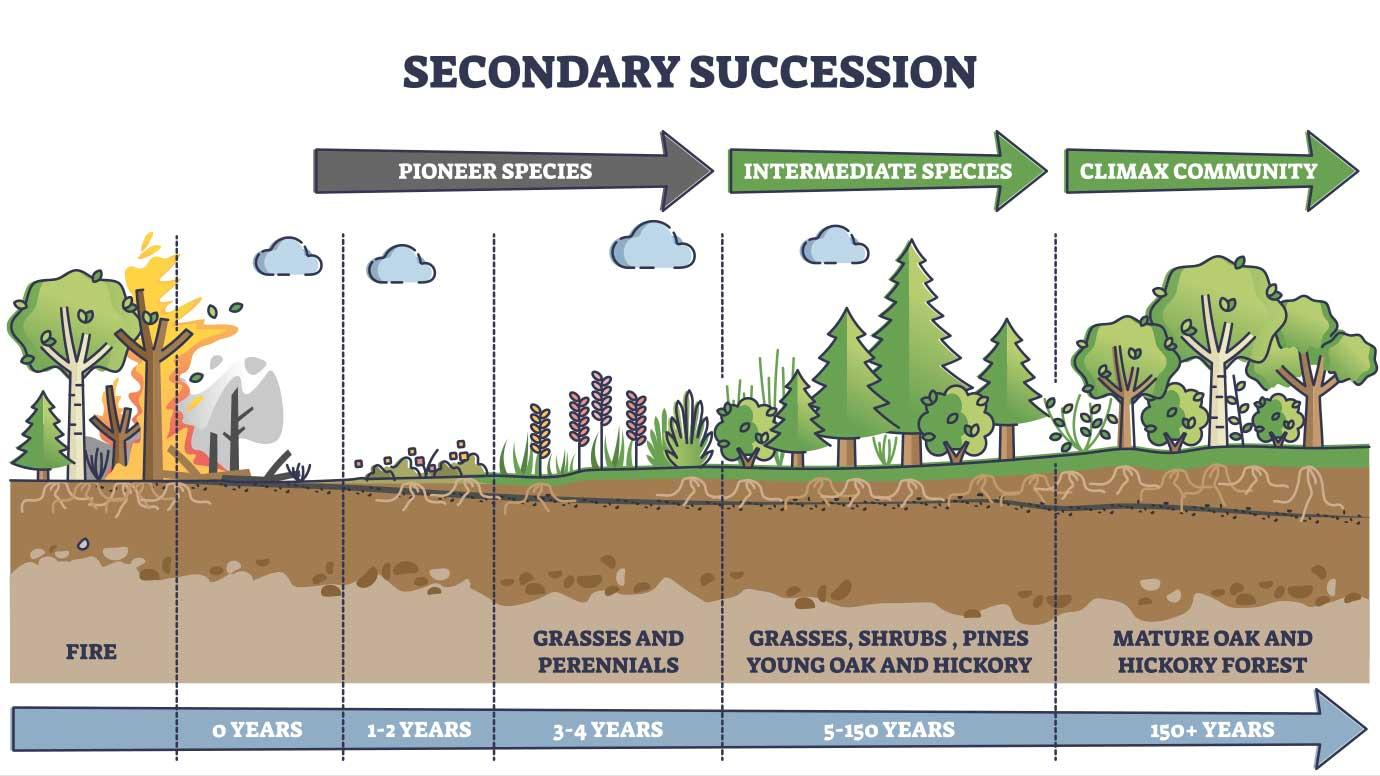
Unit 3 Review
K strategist
Examples: Humans, elephants, pandas
Often large
Long life spans
Lots of parental care
More vulnerable to extinction
It tends to be a specialist
→ has a narrow range of tolerance, particular needs
Logistic curve (S-shaped curve)
R strategist
Examples: Insects, fish
High growth rate
Often are small
Produce many offspring
Little to no parental care
tend to be generalist
→ organisms that can exist in many different environments, and have a wide range of tolerance
tend to populate quickly
Exponential curved (J-shaped curve)
Boom bust cycle
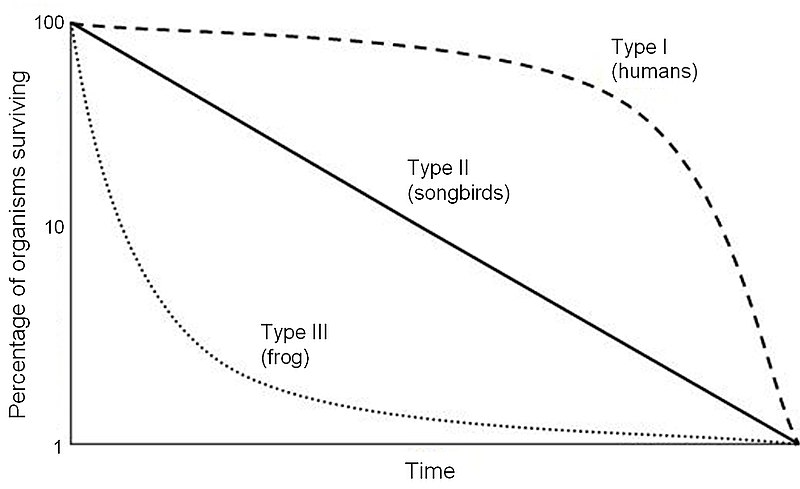 Age Structure Diagrams (Population Pyramid)
Age Structure Diagrams (Population Pyramid)
Shows the distribution of ages in a population and predicts future populations
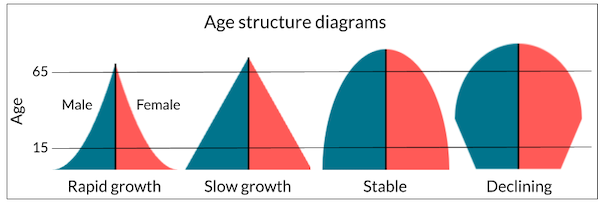 TFR (Total Fertility Rate)
TFR (Total Fertility Rate)
Varies among countries
The average number of children a woman has
Affected by age, when women have their first child
Educational opportunity
Carrying Capacity
The maximum population an area can sustain (Kr)
Desnsity Independent | Limiting Factors | Density Dependent |
|---|---|---|
Natural disasters Pollution Climate change | Finite resources constrain population growth | Number of organisms matters Competition, flood, water, space, mates, disease, predation |
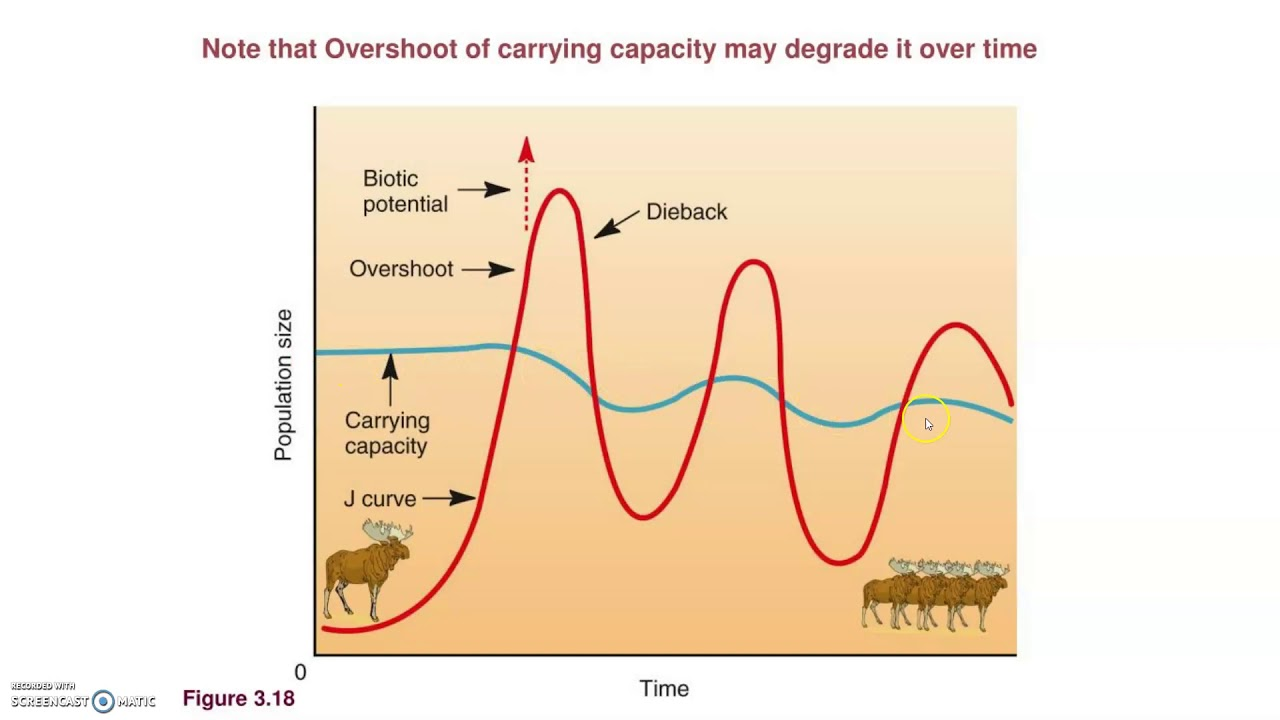
Replacement Fertility
The total fertility rate needed to keep a population stable
Global average - 2.1
Higher in some countries
→ Infant mortality rate
Greying Populations
fewer young workers to support the elderly population
More healthcare costs
Found more in declining populations
The Demographic Transition
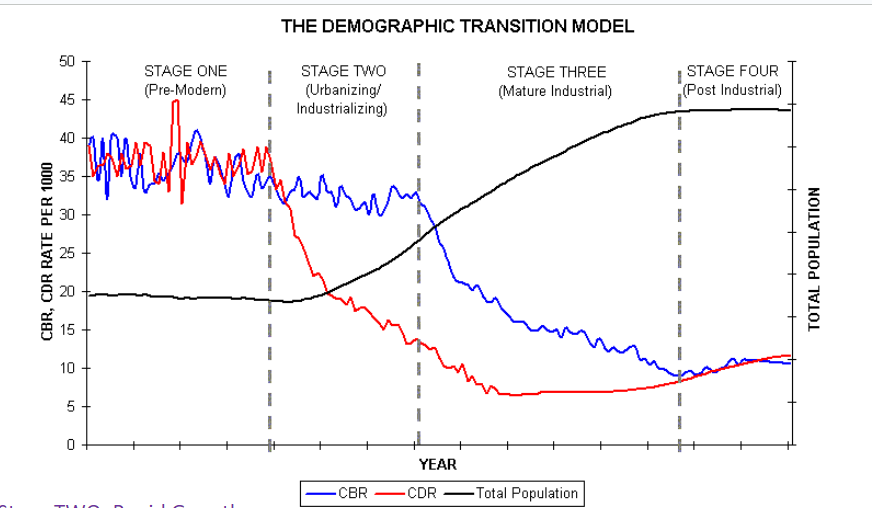
Stage One | Stage Two | Stage Three | Stage Four |
|---|---|---|---|
|
|
|
|
Birth Rate: High Death Rate: High | Birth Rate: High Death Rate: Dropping | Birth Rate: Dropping Death Rate: Low | Birth Rate: Low Death Rate: Low |
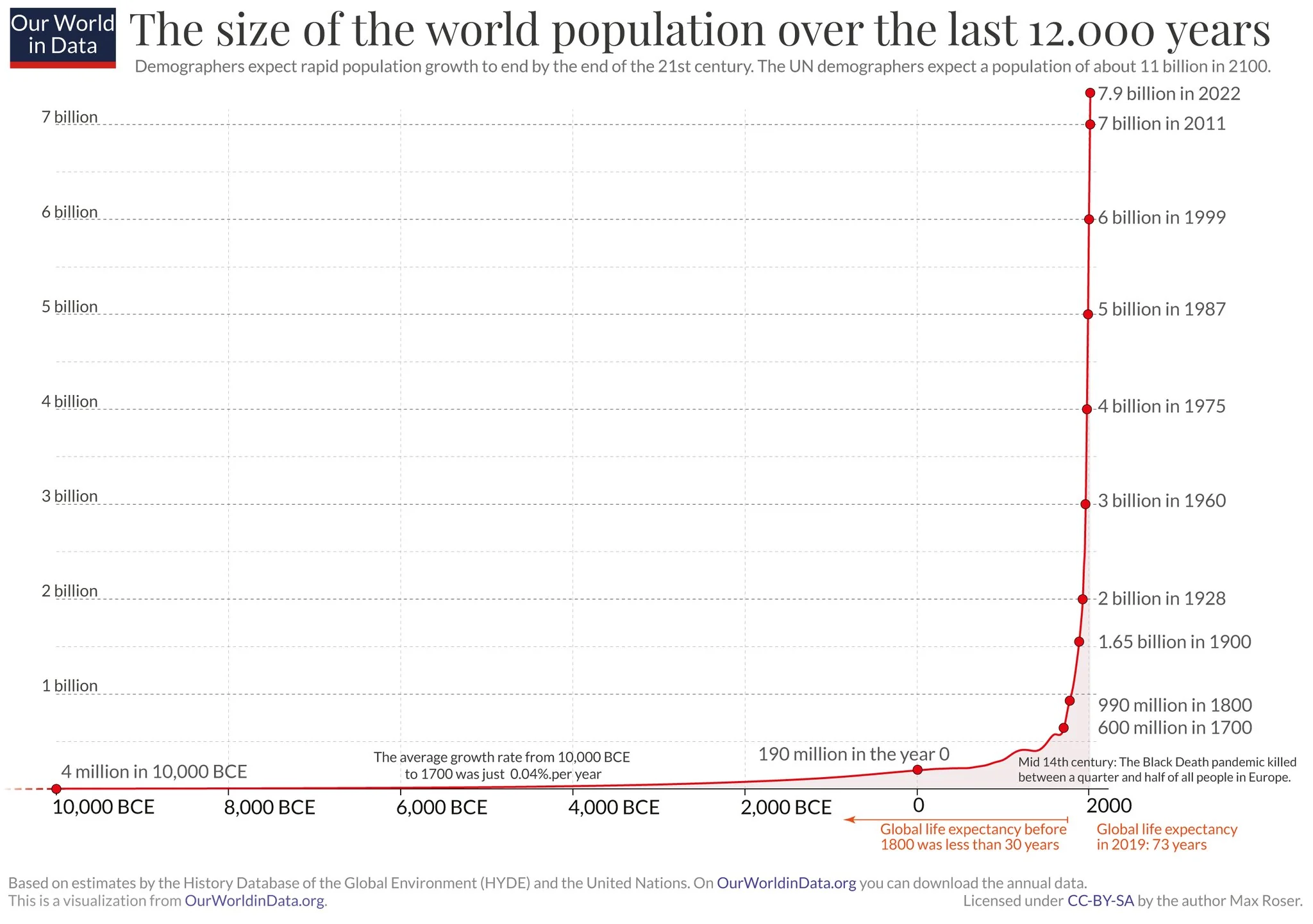 Factors that made it shoot up after 1850
Factors that made it shoot up after 1850
Advancements in medicine
The industrial revolutions
Human Population Dynamics
Global population - 8 BIllion
Fasted Growing Areas - Asian and Africa
Growth Rate - 1.1% (globally) per year
5 Most populous Areas
China
India
United States
Indonesia
Pakistan
Factors that Affect Growth Rate
Total fertility
Life expectancy
Age structure
Migration
Unit 4 Review
Formation and Erosion
Parent material in soil refers to the underlying material from which soil forms. It can be rocks, minerals, organic matter, or sediments.
Formation Affected by:
Parent material (Rock)
Over time, deeper layers form
Climate (Warm, wet climate is best)
Topography (The shape of land) (Slope can affect)
Organisms (Burrow animals)
Horizons
O Horizon
Contains mostly organic things
Usually the smallest layer
Carbon to Carbon bonds (leaves)
A Horizon
Surface soil (topsoil/humus)
Most moist, usually dark brown in color
Where most plant roots are located
E Horizon
Leaching layer, removing minerals and nutrients
It is typically lighter in color and has a higher concentration of sand and silt particles compared to the layers above and below it.
B Horizon
Characterized by the accumulation of everything
Collects minerals and nutrients. It looks and feels different from the A horizon. It helps with water, nutrients, and root movement in the soil.
C Horizon
The C horizon in soil is the deepest layer of soil, also known as the parent material. It consists of partially weathered or unweathered rock and has little to no organic matter. Its main function is to provide a source of minerals for the upper soil layers.
R Horizon
The R horizon in soil refers to the bedrock layer, which is the deepest layer of soil. It consists of unweathered parent material and is typically found beneath the other soil horizons.
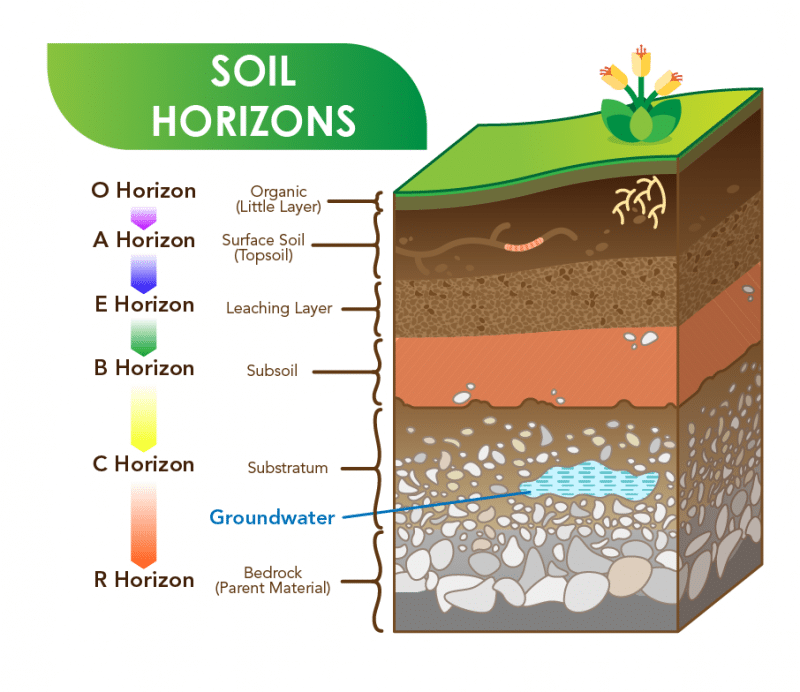 Soil
Soil
Made out of
45% Soil particles, specifically sand, silt, and clay
25% Air
5% Organic matter
Causes of Erosion
Natural: Water, wind, and gravity can cause erosion
Anthropogenic: Human-caused erosion
Deforestation
(through the roots as they hold soil in place)
Agriculture
(Tilling, messing up the soil by disrupting soil structure)
Pesticides and Fertilizer
(Changes the chemistry of the soil)
Overgrazing
(Short grass = short roots)
Composition and Properties
What is it?
A renewable resource that can be replenished but can also be depleted (this is a cycle)
Porosity
The space between particles
Sand has a high porosity
Silt has a medium porosity
Clay has a low porosity
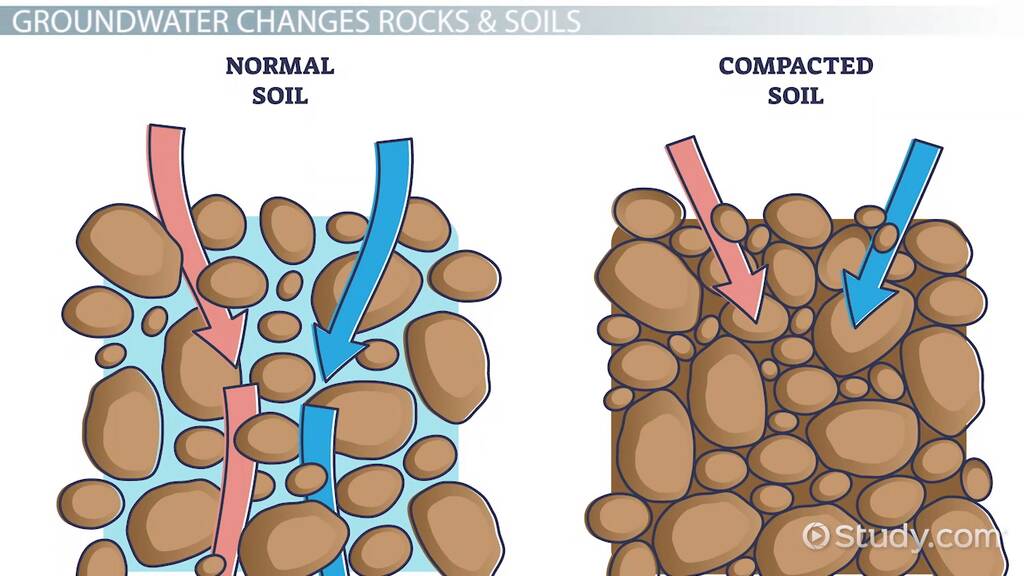 Permeability
Permeability
Porosity affects permeability
Permeability is the ability for water to move through different materials
Clay has a low permeability
Silt has a medium permeability
Sand has a high permeability
This is because each of these materials is compacted in different intensities
Water Holding Capacity
Permeability affects water-holding capacity
How well soil can hold water
Clay has a high water-holding capacity
Silt has a medium holding capacity
Sand has a medium holding capacity
The water-holding capacity of different materials varies based on their physical and chemical properties, such as porosity, surface area, and chemical composition. Materials with high porosity and larger surface area, like soil, can hold more water compared to materials with low porosity and smaller surface area, such as rocks or metals.
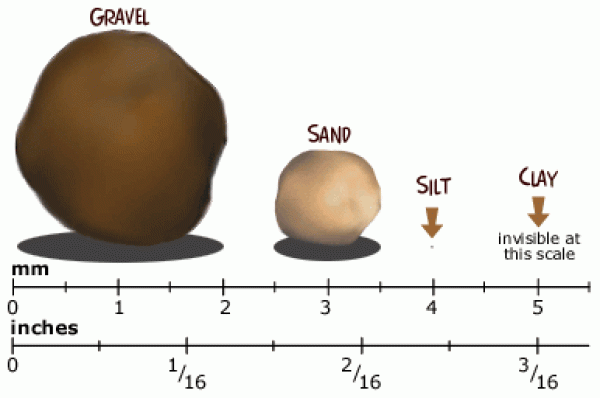 Chemical Properties
Chemical Properties
Plants need nutrients to grow
These nutrients are found in soil
Nitrogen (N)
Phosphorus (P)
Potassium (K)
pH
These factors can affect the growth of plants. Adjusting these elements to what fits best will lead to better plant growth.
Biological Properties
Organisms put nutrients in the soil due to decomposition
Soil Texture Triangle
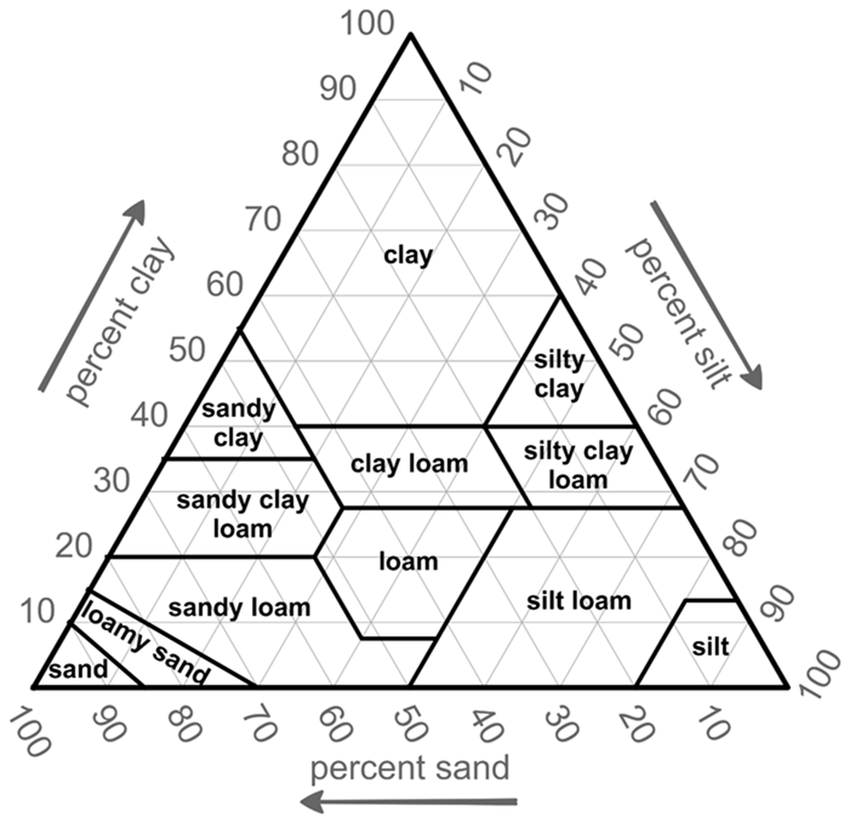
Unit 5 Review
Sustainable Forestry
Timber Market Value - Economic value.
Lumber - which is when timber is shaped can be used for paper, houses, and energy
Ecological Value
Trees provide habitat, which helps moderate the local climate
Prevents soil erosion
Helps with soil formation
Helps reduce runoff
Helps store carbon
What is sustainability?
Sustainable forestry is using sustainable methods to log trees
Reusing wood
Protecting Forests |
|---|
From Pests:
|
From Wildfires:
|
Clearcutting - Cutting down trees all at the same time which leads to even-aged stands
Even-aged - These grow all at the same size
Uneven-aged stems: Trees grow at different sizes
The Green Revolution
Industrial agriculture - Mechanization and standardization applied to food reproduction
Pros | Cons |
|
|
GMOs
Genetically Modified Organisms
Pros | Cons |
|
|
Irrigation
Waterlogging - Roots that cannot get enough oxygen due to water
Salinization - Too much salt left behind through evaporation or saltwater intrusion which is toxic for plant growth
Ogallala Aquifer - A water table aquifer surrounded by sand, silt, clay, and gravel. Located beneath the great plains as one of the world’s largest aquifers.
Description | Pros | Cons | |
Flood | Flood the field and let the water soak in evenly | Easy, cheap 65% | Waterlogging/salinization |
Furrow | Build trenches and fill them with water | Low effort, cheap 75% | Waterlogging/salinization |
Spray | Pumped through nozzles | More efficiency 75-95% | More costly, uses more energy |
Drip | Slowly dripping hose, buried or on top | Most efficiency. Reduces week growth and keeps surface soil dry >95% | Most costly; might need to remove to plow |
Pest Control
Pesticides are substances used to control or eliminate pests, such as insects, weeds, and fungi, to protect crops and prevent plant damage.
Pros: Increases crop yield s while decreasing damage from pests
Cons: Human health risk, bioaccumulation, biomagnification, and can kill non-target organisms
Biocontrol
Biocontrol refers to using living organisms or their products to control pests or diseases in agriculture and forestry, reducing the reliance on chemical pesticides.
Pros: No chemicals
Cons: Species can become invasive
IPM
The goal of IPM is to use a variety of methods to control the number of pests (not trying to fully eradicate) and minimize the environmental impact
Biological Methods | Physical Methods | Chemical Methods |
Bio Control | Fences and Screens | Used less |
Sustainable Soil
Dust Bowl The soil was eroded which resulted in dust | Contour Plowing Stopping erosion by planting crops in circles | Terracing Farms in steps on a mountain to prevent soil erosion |
Strip Cropping Planting two or more crops together to help put nutrients into the soil | Windbreaks Trees block wind to prevent soil erosion | No Tilling Not raking up soil so soil does not erode away |
2+ Perennials Crops that grow back every year leads to less soil erosion | Crop Rotation Moving crops from field to field to keep soil fertile | Green Manure/Limestone Helps to decrease acidity |
Uses
Organic fertilizer needs to be gathered (synthetic)
Nutrient levels unknown
Harder to use, synthetic is easier
Meat Production
Free Range
Can overgraze which causes desertification
Waste can be spread over large areas
Benefit: Animals have access to the outdoors
CAFOs
Concentrated animal feeding operations
Increased antibiotic use
ethical concerns
waste issues
Benefit: Effective method of producing meat because it is cost-efficient
Why eat less meat?
Leads to a decrease in greenhouse gases (methane), a decrease in land and water use, and a decrease in antibiotic use.
Aquaculture
Cost-effective
Less fuel used
Cons:
Genetically modified fish can mate with native fish
Waste issues
Over Fishing
How can we turn this around?
Catch limit
Treaties - CITES
Laws - Endangered species act
So many fish are being taken away, what will be the consequences?
Loss of biodiversity
Mining
Surface mining
Strip, open pit, or mountaintop
Substance mining tunnels under the ground
What do we mine for?
Coal, gravel, sand, diamonds
They are harvested as ore and then refined
Mining
→Refinement
→Transportation
→Use
→Desposal
Impacts
Soil erosion
Dust pollution
Fossil fuel use
Water pollution
Mercury can be used to separate gold from ore which leads to mercury pollution as well
Cyanide is often used
Acid mine drainage
Tailings can contain sulfur that can form sulfuric acid
Remediation
Turn mine into a recreational area
Replant vegetation to combat acid mine drainage
The Impacts of Urbanization
Benefits:
| Disadvantages:
|
Heat and Island Effect
Average temperatures are several degrees warmer in cities than in suburbs and other areas
Solutions
Paint rooftops a lighter color
Plant rooftop vegetation
Reduce Impacts
Mass transit
Permeable surfaces (pavements and more parks)
Walkable cities
Impact on Water Cycle
More runoff and less infiltration in cities from impervious surfaces
Change that into more permeable surfaces through rooftop gardens and permeable pavement
Formation and Erosion
Parent material in soil refers to the underlying material from which soil forms. It can be rocks, minerals, organic matter, or sediments.
Formation Affected by:
Parent material (Rock)
Over time, deeper layers form
Climate (Warm, wet climate is best)
Topography (The shape of land) (Slope can affect)
Organisms (Burrow animals)
Horizons
O Horizon
Contains mostly organic things
Usually the smallest layer
Carbon to Carbon bonds (leaves)
A Horizon
Surface soil (topsoil/humus)
Most moist, usually dark brown in color
Where most plant roots are located
E Horizon
Leaching layer, removing minerals and nutrients
It is typically lighter in color and has a higher concentration of sand and silt particles compared to the layers above and below it.
B Horizon
Characterized by the accumulation of everything
Collects minerals and nutrients. It looks and feels different from the A horizon. It helps with water, nutrients, and root movement in the soil.
C Horizon
The C horizon in soil is the deepest layer of soil, also known as the parent material. It consists of partially weathered or unweathered rock and has little to no organic matter. Its main function is to provide a source of minerals for the upper soil layers.
R Horizon
The R horizon in soil refers to the bedrock layer, which is the deepest layer of soil. It consists of unweathered parent material and is typically found beneath the other soil horizons.
 Soil
Soil
Made out of
45% Soil particles, specifically sand, silt, and clay
25% Air
5% Organic matter
Causes of Erosion
Natural: Water, wind, and gravity can cause erosion
Anthropogenic: Human-caused erosion
Deforestation
(through the roots as they hold soil in place)
Agriculture
(Tilling, messing up the soil by disrupting soil structure)
Pesticides and Fertilizer
(Changes the chemistry of the soil)
Overgrazing
(Short grass = short roots)
Porosity
The space between particles
Sand has a high porosity
Silt has a medium porosity
Clay has a low porosity

Permeability
Porosity affects permeability
Permeability is the ability for water to move through different materials
Clay has a low permeability
Silt has a medium permeability
Sand has a high permeability
This is because each of these materials is compacted in different intensities
Water Holding Capacity
Permeability affects water-holding capacity
How well soil can hold water
Clay has a high water-holding capacity
Silt has a medium holding capacity
Sand has a medium holding capacity
The water-holding capacity of different materials varies based on their physical and chemical properties, such as porosity, surface area, and chemical composition. Materials with high porosity and larger surface area, like soil, can hold more water compared to materials with low porosity and smaller surface area, such as rocks or metals.
 Chemical Properties
Chemical Properties
Plants need nutrients to grow
These nutrients are found in soil
Nitrogen (N)
Phosphorus (P)
Potassium (K)
pH
These factors can affect the growth of plants. Adjusting these elements to what fits best will lead to better plant growth.
Biological Properties
Organisms put nutrients in the soil due to decomposition
Soil Texture Triangle

 Knowt
Knowt
